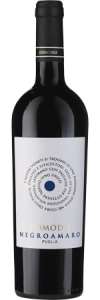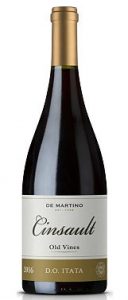We tasted: Cantina di Montalcino Brunello di Montalcino, M&S
Tasting Notes
 Emma says: “I start our final tasting week with a mix of relief and a tinge of sadness. If I’m honest, we took on a bigger project than I imagined.
Emma says: “I start our final tasting week with a mix of relief and a tinge of sadness. If I’m honest, we took on a bigger project than I imagined.
Finding, tasting and writing about one wine a week was more demanding than I thought. Not to mention, I didn’t realise Andy would be quite the taskmaster. Apparently my grammar is pretty poor, and he’s been doing a heavy red pen edit on it each week!
But at the same time, it has been a fun project to share and I do now understand what Andy does and doesn’t like a lot better which was the fundamental thing I was trying to achieve. The feedback we have received from you all has also been great and is a real motivator for us to carry on into 2019.
Sangiovese wasn’t the obvious choice as a final grape but I’m now really pleased. Just pouring this glass of wine I knew it was going to be a total “old skool” classic. It has that brown red hue of an aged classic wine, and the aroma that springs from the glass is full of that complex savoury charm; balsamic, leathery and smoky with brooding cherry fruits underlying. All these layers of character come through as the wine changes and reacts with age, and this to me is what make this wine so interesting. To taste it had that certain rusticity that can make Sangiovese so distinct, a chalky texture to the tannins, and acidity really bursting in the mouth. What made this wine sit above the average Sangiovese (as Brunello should) was the decent weight of dark cherry and plums working alongside that tannin and an array of flavours, from dried herbs, to orange peel, cinnamon and an earthy clay note. All working in balance so they don’t fight with each other.
I’m glad we traded up to Brunello. Chianti is often overlooked as a simple pizza restaurant wine, but it can be so interesting when made in the right hands.”
Andy says: “The final week, and unfortunately I have my first/last cold of the year, and I can’t taste a thing.
Or, maybe this wine is just fairly insipid. The first thing I noticed was the high acidity, and I think this is the third wine this year that has made me do the ‘sour shudder’, although perhaps it needs to be rebranded as the ‘acid attack’. The only thing I can agree with from Emma’s notes is the brown/red hue. I’m going to have to re-taste in a day or so when my head clears up.”
Buying Guide
Sangiovese is the grape behind Tuscan wines, especially Chianti. It has a light colour and flavour but a distinct tea leaf textured tannin which gives it a unique character. The best Sangiovese tends to be in the Chianti Classico hillside areas. We will be looking for one form a great producer to end our 52 weeks on a high note.


 Emma says: “Coming soon!”
Emma says: “Coming soon!”
 Emma says: “This week we are on to the lesser known but classic wine style that is 100% Cabernet Franc, originating from the Loire region in France. I found a Saumur in our trusty local Nicolas wine shop, a great place for searching out random regional French wines.
Emma says: “This week we are on to the lesser known but classic wine style that is 100% Cabernet Franc, originating from the Loire region in France. I found a Saumur in our trusty local Nicolas wine shop, a great place for searching out random regional French wines.
 Emma says: “I couldn’t help but smile when we opened the bottle of Beaujolais Nouveau. There is something about this type of wine that spells pure joy to me.
Emma says: “I couldn’t help but smile when we opened the bottle of Beaujolais Nouveau. There is something about this type of wine that spells pure joy to me.
 Emma says: “And the big judgement commences. For once we have managed to strike gold and have a lovely bottle of St Emilion Grand Cru at home; a welcome break from scouring the shops for our weekly grape.”
Emma says: “And the big judgement commences. For once we have managed to strike gold and have a lovely bottle of St Emilion Grand Cru at home; a welcome break from scouring the shops for our weekly grape.”
 Emma says: “Today kicked off with a full morning of judging Albarino wines from Spain and Portugal. Then into an afternoon of mulling over Beaujolais samples. Finished off by approving a few Champagne blends. Yes, this is the type of day all my friends tell me is my job. However the honest truth right now, is that I spend a disproportionately higher time updating spreadsheets.
Emma says: “Today kicked off with a full morning of judging Albarino wines from Spain and Portugal. Then into an afternoon of mulling over Beaujolais samples. Finished off by approving a few Champagne blends. Yes, this is the type of day all my friends tell me is my job. However the honest truth right now, is that I spend a disproportionately higher time updating spreadsheets.
 We tasted: Houdamond Pinotage, £13, M&S
We tasted: Houdamond Pinotage, £13, M&S
 Emma says: “
Emma says: “
 Emma says: “This week Andy really held me back. I was ready to crack open a fine bottle of Bordeaux for our Cabernet experience. One of those really pricey bottles that I’ve saved for a “special” occasion. Since I never seem to find a grand enough moment to fit opening one, I thought 52 grapes might fit the bill. But no, Andy was my kill joy, he said we needed to find something similar to what other readers might be drinking. Do I sound bitter?
Emma says: “This week Andy really held me back. I was ready to crack open a fine bottle of Bordeaux for our Cabernet experience. One of those really pricey bottles that I’ve saved for a “special” occasion. Since I never seem to find a grand enough moment to fit opening one, I thought 52 grapes might fit the bill. But no, Andy was my kill joy, he said we needed to find something similar to what other readers might be drinking. Do I sound bitter?
 Emma says: “I’ve been looking forward to this week because I knew exactly which wine I wanted us to taste. It is actually quite rate to find a 100% Cinsault wine but I have fortunately found my ultimate one when visiting a favourite Chilean producer De Martino three years ago.
Emma says: “I’ve been looking forward to this week because I knew exactly which wine I wanted us to taste. It is actually quite rate to find a 100% Cinsault wine but I have fortunately found my ultimate one when visiting a favourite Chilean producer De Martino three years ago.